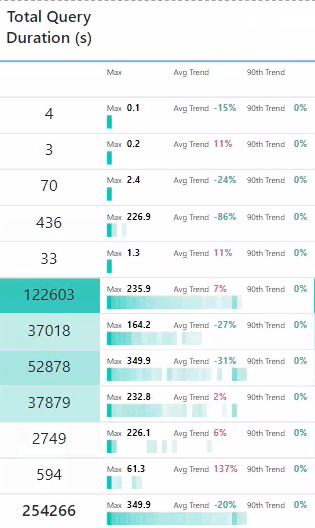Optimizing the SVG Heatmap
Optimizing the SVG Heatmap using the Sparkline measure pattern
A quick post that is the cumulation of a couple of previous posts, optimizing the heatmap SVG using the Power BI Sparklines pattern.
Performance¶
Running on the Fabric Log Analytics for Analysis Services Engine report template hydrated with a months worth of logs. I captured the query that generated the following matrix.
Command CPU (s) Heatmap SVG =
VAR __svgHeight = 20
VAR __svgWidth = 150
VAR _numBoxes = 40
VAR _boxWidth = __svgWidth / _numBoxes
VAR __Categories = VALUES( ExecutionMetrics[XmlaRequestId] )
VAR __Range =
MAXX(
ALLSELECTED( ExecutionMetrics[XmlaRequestId] ),
CALCULATE(
SUM( ExecutionMetrics[totalCpuTimeMs] ) / 1000
,ExecutionMetrics[LogAnalyticsCategory]= "Command"
,REMOVEFILTERS( Artifact )
)
)
VAR __Data =
ADDCOLUMNS(
KEEPFILTERS(
FILTER(
KEEPFILTERS( __Categories ),
not ISBLANK(
CALCULATE(
SUM( ExecutionMetrics[totalCpuTimeMs] ) / 1000
,ExecutionMetrics[LogAnalyticsCategory]= "Command"
)
)
)
),
"@box",
INT(
(
CALCULATE(
SUM( ExecutionMetrics[totalCpuTimeMs] ) / 1000
,ExecutionMetrics[LogAnalyticsCategory]= "Command"
) / __Range
) * (_numBoxes - 1 )
) + 1
)
VAR _countPerBox =
ADDCOLUMNS(
SUMMARIZE( __Data, [@box] )
,"@x", ( [@box] * _boxWidth ) - _boxWidth // could do this elsewhere
,"@cnt",
VAR _box = [@box]
RETURN
CALCULATE( COUNTX ( __Data, IF( [@box] = _box && _box <> 0, 1 ) ) )
)
VAR _cntRange = MAXX( _countPerBox, [@cnt] )
VAR __Boxes =
CONCATENATEX(
ADDCOLUMNS(
_countPerBox
,"@Boxes"
,// Mapping values range 0 -> 255
VAR _inputStart = 0 // The lowest number of the range input
VAR _inputEnd = LOG( _cntRange, 10 ) // The largest number of the range input
VAR _outputStart = 255 // The lowest number of the range output
VAR _outputEnd = 0 // The largest number of the range output
VAR _outputVal = _outputStart + ((_outputEnd - _outputStart) / (_inputEnd - _inputStart)) * ( LOG( [@cnt], 10 ) - _inputStart)
// https://dax.tips/2019/10/02/dax-base-conversions/
VAR ConvertMe = IFERROR( _outputVal, 255 )
VAR Base = 16
VAR BitTable = GENERATESERIES ( 1, 8 )
VAR DEC2HEX =
CONCATENATEX(
BitTable,
VAR c = MOD( TRUNC ( ConvertMe / POWER ( base, [value] - 1 ) ), base )
RETURN SWITCH(c,10,"A",11,"B",12,"C",13,"D",14,"E",15,"F",c),
,[Value],Desc
)
VAR HEX = "#" & REPT( RIGHT( DEC2HEX, 2 ), 3 ) & IF( ConvertMe = 255, "00", "" )
RETURN
"<rect id='box' x='" & [@x] & "' y='" & __svgHeight / 2 & "' width='" & _boxWidth & "' height='" & __svgHeight / 2 & "' fill='" & HEX & "' filter='url(#gradient)'/>"
)
,[@Boxes]
," "
,[@x]
)
// Trends
var dt = MAX( Dates[Date] )
var _greenHex = "#37A794"
var _redHex = "#DD6B7F"
VAR __MaxVal =
MAXX(
VALUES( ExecutionMetrics[XmlaRequestId] ),
CALCULATE(
SUM( ExecutionMetrics[totalCpuTimeMs] ) / 1000
,ExecutionMetrics[LogAnalyticsCategory]= "Command"
)
)
// Avg Trend
var _MonthAverageAvg =
CALCULATE(
AVERAGEX( VALUES( ExecutionMetrics[XmlaRequestId] ), CALCULATE( SUM( ExecutionMetrics[totalCpuTimeMs] ) ) / 1000 )
,REMOVEFILTERS( Dates )
,DATESINPERIOD( Dates[Date], dt, -1, MONTH )
,ExecutionMetrics[LogAnalyticsCategory] = "Command"
)
var _WeekAverageAvg =
CALCULATE(
AVERAGEX( VALUES( ExecutionMetrics[XmlaRequestId] ), CALCULATE( SUM( ExecutionMetrics[totalCpuTimeMs] ) ) / 1000 )
,REMOVEFILTERS( Dates )
,DATESINPERIOD( Dates[Date], dt, -7, DAY )
,ExecutionMetrics[LogAnalyticsCategory] = "Command"
)
Var _trendAvg = IF( not ISBLANK( _MonthAverageAvg ), (1 - ( _WeekAverageAvg / _MonthAverageAvg )) * - 1 )
Var _trendAvgHex = IF( _trendAvg > 0, _redHex, _greenHex )
// 90 Percentile Trend
var _MonthAverage90th =
CALCULATE(
PERCENTILEX.INC( VALUES( ExecutionMetrics[XmlaRequestId] ), CALCULATE( SUM( ExecutionMetrics[totalCpuTimeMs] ) ) / 1000, 0.9)
,REMOVEFILTERS( Dates )
,DATESINPERIOD( Dates[Date], dt, -1, MONTH )
,ExecutionMetrics[LogAnalyticsCategory] = "Command"
)
var _WeekAverage90th =
CALCULATE(
PERCENTILEX.INC( VALUES( ExecutionMetrics[XmlaRequestId] ), CALCULATE( SUM( ExecutionMetrics[totalCpuTimeMs] ) ) / 1000, 0.9)
,REMOVEFILTERS( Dates )
,DATESINPERIOD( Dates[Date], dt, -7, DAY )
,ExecutionMetrics[LogAnalyticsCategory] = "Command"
)
Var _trend90th = IF( not ISBLANK( _MonthAverage90th ), (1 - ( _WeekAverage90th / _MonthAverage90th )) * - 1 )
Var _trend90thHex = IF( _trend90th > 0, _redHex, _greenHex )
VAR __Svg =
"data:image/svg+xml;utf8, <svg width=""" & __svgWidth & """ height=""" & __svgHeight &""" xmlns=""http://www.w3.org/2000/svg"">" &
"<defs>
<filter id=""gradient"" color-interpolation-filters=""sRGB"">
<feComponentTransfer>
<feFuncR type=""table"" tableValues=""1 0.975"" />
<feFuncG type=""table"" tableValues="" 0.78 0.975"" />
<feFuncB type=""table"" tableValues=""0.2 0.975"" />
</feComponentTransfer>
</filter>
</defs>" &
"<text x='0' y='7' fill='black' font-size='6' font-family='Segoe UI, sans-serif'>Max</text>" &
"<text x='15' y='7' fill='black' font-size='7' font-family='Segoe UI, sans-serif' font-weight='bold'>" & FORMAT(__maxVal, "0.0") & "</text>" &
"<text x='45' y='7' fill='black' font-size='6' font-family='Segoe UI, sans-serif'>Avg Trend</text>" &
"<text x='75' y='7' fill='" & _trendAvgHex & "' font-size='7' font-family='Segoe UI, sans-serif' font-weight='bold'>" & FORMAT(_trendAvg, "0%") & "</text>" &
"<text x='100' y='7' fill='black' font-size='6' font-family='Segoe UI, sans-serif'>90th Trend</text>" &
"<text x='130' y='7' fill='" & _trend90thHex & "' font-size='7' font-family='Segoe UI, sans-serif' font-weight='bold'>" & FORMAT(_trend90th, "0%") & "</text>" &
__Boxes &
"</svg>"
RETURN
IF( not ISEMPTY(__Data), __Svg )
Running server timing on DAX Studio you can see that the old code causes the materialization of a large data cache and uses a large amount of formula engine, taking nearly 3 seconds. Adjusting the code to a similar pattern to sparklines we reduce this by 90% to 347ms, with no large materialization.
Conclusions¶
This is a fantastic pattern, that is reasonably easy to implement and obtain good results. Of note I test the performance of the Violin plot, and it already very good, and doesn't require any improvement.


